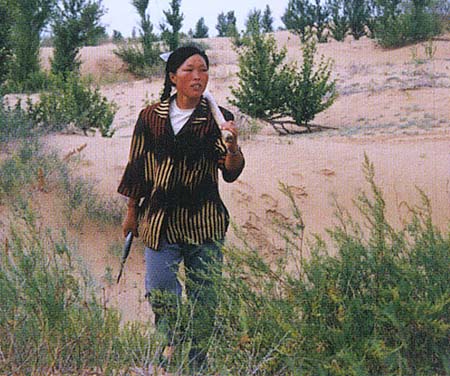| Home / Environment / Public Endeavor | Tools: Save | Print | E-mail | Most Read |
| Forestry Projects Take Root in Desert |
| Adjust font size: |
Yin Yuzhen, a native of the Inner Mongolia Autonomous Region who is renowned for combating sandstorms in the hinterlands of the Maowusu Desert, once said she would rather work herself to death fighting the sand than be tortured to death by it blowing in the wind.
Data from the region's forestry department shows that since 1985, Yin has converted more than 4,000 hectares of desolate desert into habitable green space. In 1985 the then 20-year-old Yin married in Jingbeitang village, of which her family members were the sole residents because of the wild, desolate conditions. Yin recalled the day when she saw the first outsider pass by her house. It was more than 40 days after she married. "I was so excited that I took a basin and covered up one of the footprints he had left," she said. "I took a look at it every day after that." "When the wind blew, the yellow sand blanketed everything, and my face ached after I washed it at night." But Yin would not let the desert break her spirit. She started to plant trees in 1985. One by one, she planted the saplings, and after a year, most of them survived, despite the harsh conditions. With her family's support - as well as input from the government and other people - she has grown enough trees to halt the dunes' advance and shelter her village from the ferocious sandstorms. In more recent years, Yin helped her village become a tourist attraction. Many outsiders are awed by how she has helped lift Jingbeitang out of poverty. It is now home to many orchards and animal husbandry projects. Others have followed Yin's example by setting up their own eco-defense lines against the advancing desert in northern Li Shuping, vice-director of the region's forestry department, said: "We have all kinds of social participation in forestry development. The most important policy is that investors are the beneficiaries of the projects. They own whatever they plant."
In Erdos city, investors have shown great interest in such projects because of the tremendous economic benefits they bring. For example, one hectare of sand willow planted in the desert can generate up to 8,400 yuan (US$1,100) every two years, according to official figures. "The joint efforts of the forestry department and society at large have significantly decreased desertification and increased incomes for farmers," Li said. By the end of 2005, the region's forestry industry was worth 10 billion yuan, a 4.6 billion yuan increase from 2000. Farmers' average per capita income from forestry projects had increased by 245 yuan. The amount of land covered by forest has increased to 17.6 percent of the region's total area from 14.8 percent in 1999, according to the region's chairman Yangjing. Since 2003, at least 3 billion yuan have been earmarked to implement the "Beijing-Tianjin windblown sand sources control project" in a bid to build a green ecological belt in northern The project involves 458,000 sq km of land, 48 percent of which lies in Water and soil conservation forests have been set up in fragile areas in 85 counties. By 2010, the region wants to increase forest coverage to 20 percent, representing economic value of 18.3 billion yuan. ( |
| Tools: Save | Print | E-mail | Most Read |
 |
| Related Stories |
|
|||


